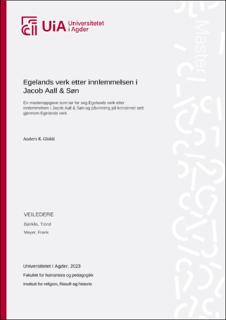| dc.description.abstract | Abstract
The purpose on this work has been to shed light on the incorporation of Egeland Ironworks
into Jacob Aall & Søn, and issues connected to this leading up to the bankruptcy in 1884.
First, I present Egeland ironworks trade network through receipts. The main source material
has been receipts that stem from 1873 to 1875. Egeland ironworks had a large network with
a wide set of products they could produce. To the countries Egeland ironworks traded with,
Germany was the most important, followed by Great Britain, Switzerland and Denmark. Still,
the trade was highly centered around Norway and Germany with over 85 percent of the
receipts going to these two countries.
In the second part of this paper, I present a historiography on why the Norwegian ironworks
shut down during the 19th century. The main points in this historiography have been
connected to charcoal, iron prices and the handling of the bankruptcies. Afterwards I point
to the problems arising at Egeland Ironworks during its last decade. Here I have used letters
from Egeland ironworks manager from 1878 and towards 1884. The problems here are
connected to liquidity issues, large discounts when paying in cash and sale of minerals with
no profits. The group managed to stay afloat to 1884, long past the other ironworks, even
though they faced a difficult market and unrest connected to monetary problems.
In the end of this paper, I investigate the purchase of Egeland ironworks, and its value. In
this part I discuss two articles that shed light on how involved Egeland ironworks was in the
group’s bankruptcy. The source material here points to both local problems but also
problems tied up to the general trend in Norway.
The paper concludes with, that the value of Egeland was attractive because of its broad
network, ample forests and high-quality iron ore and products. The timing on the other hand
was unfortunate, both for Jacob Aall & Søn and the general ironworks trend in the country.
For Nicolai Benjamin Aall, the owner of Jacob Aall & Søn, this investment further added to
his debt while iron prices continued to decline | |
